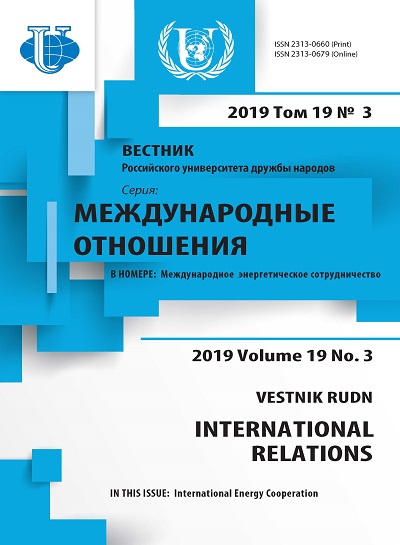Great Powers’ Competition in the Arctic: Geopolitical Rivalry in the New Political Space
- Authors: Nikulin M.A.1
-
Affiliations:
- RUDN University
- Issue: Vol 19, No 3 (2019): International Energy Cooperation
- Pages: 392-403
- Section: THEMATIC DOSSIER
- URL: https://journals.rudn.ru/international-relations/article/view/22589
- DOI: https://doi.org/10.22363/2313-0660-2019-19-3-392-403
Cite item
Full Text
Abstract
For the past few decades, the Arctic Ocean has experienced a rapid reduction in both the extent and amount of sea ice. These events, caused by global temperature increase, opened previously inaccessible sea shipping lanes and made possible the extraction of natural resources from deposits previously inaccessible. Such changes entailed an increase in the activity of states both belonging to the Arctic region and those outside it - this led to a gradual increase in rivalry between the leading powers for the development of resources in the Arctic and for the control of shipping routes. The author points out that in the Arctic, unlike other regions, a unique situation has developed due to the interdependence of all actors, which is associated with the special environmental conditions and the commonality of both economic and public interests. The author analyzes the way how the great powers interaction affects the Arctic region. Using the example of the growing Russian-American rivalry being key for the Arctic, the author stresses a softening effect of the institutional regional base. Against this background, the level of interest of another leading power in this region - the PRC - is also growing. Unlike the Russian Federation and the USA, China adheres to the non-confrontational path in the Arctic region, advocating peace and stability strategy, which is associated mainly with the natural resource potential of the Arctic and the possibilities of using the Northern Sea Route. As a result, the rivalry of states in the northern latitudes can be described in terms of the Cold War competition on a regional scale.
About the authors
Maksim Andreevich Nikulin
RUDN University
Author for correspondence.
Email: nikulin-ma@rudn.ru
Research Assistant, Department of Theory and History of International Relations
Moscow, Russian FederationReferences
- Babin, J. & Lasserre, F. (2019). Asian States at the Arctic Council: Perceptions in Western States. Polar Geography, 42 (3), 145—159. DOI: https://doi.org/10.1080/1088937X.2019.1578290
- Beixi, D. (2016). Arctic Geopolitics. The Impact of U.S.-Russian Relations on Chinese-Russian Cooperation in the Arctic. Russia in Global Affairs, 14 (2), 206—220.
- Brady, A.-M. (2017). China as a Polar Great Power. Cambridge University Press.
- Chen, G. (2012). China’s Emerging Arctic Strategy. The Polar Journal, 2 (2), 358—371. DOI: https://doi.org/10.1080/ 2154896X.2012.735039
- Cole, B.D. (2001). The Great Wall at Sea: China’s Navy Enters the Twenty-First Century. Annapolis: Naval Institute Press.
- Emelyantseva, M.O. (2014). The Greenland Question in Danish-American Relations in the 1940s. Vestnik RUDN. International Relations, 1, 104—111. (In Russian).
- Gramer, R. (2017). Here’s What Russia’s Military Build-Up in the Arctic Looks Like. Foreign Policy, January 25, 2017. URL: https://foreignpolicy.com/2017/01/25/heres-what-russias-military-build-up-in-the-arctic-looks-like-trump-oilmilitary-high-north-infographic-map/ (accessed: 01.07.19).
- Jakobson, L. & Peng, J. (2012). China’s Arctic Aspirations. SIPRI Policy Paper, 34.
- Kankaanpää, P. & Young, O.R. (2012). The Effectiveness of the Arctic Council. Polar Research, 31 (1), 1—14. DOI: https://doi.org/10.3402/polar.v31i0.17176
- Konyshev, V.N. & Kobzeva, M.A. (2017). Politics of China in the Arctic: Traditions and Modernity. Comparative Politics, 8 (1), 77—92. (In Russian). DOI: https://doi.org/10.18611/2221-3279-2017-8-1-77-92
- Konyshev, V.N. & Sergunin, A.A. (2018). Arctic 2018: Is the Spirit of the Ilulissat Declaration Alive? Russian International Affairs Council. URL: https://russiancouncil.ru/analytics-and-comments/analytics/arktika-2018-zhiv-li-dukh-ilulissatskoydeklaratsii/ (accessed: 02.07.2019). (In Russian).
- McKellar, S. (2018). Freezing Hot: Escalating Tensions in the Arctic. Chicago Journal of Foreign Policy, 2 (2), 358—371. DOI: https://doi.org/10.1080/2154896X.2012.735039
- Pawluszko, T. (2012). Theory of International Relations in Search of the Arctic Situation’s Definition. Towards the Perspective of International Regimes. In: Czarny, R.M., Kubicki, R., Janowska, A. & Czarny, R.S. The Northern Spaces — Contemporary Issues. Warszawa: Kielce. P. 117—128.
- Savoiskii, A.G. (2012). Joint Development of the Arctic as an Opportunity to Improve Economic Relations between Russia and the USA. Vestnik RUDN. International Relations, 2, 51—59. (In Russian).
- Stensdal, I. (2013). Asian Arctic Research 2005—2012: Harder, Better, Faster, Stronger. FNI Report, 3.
- Wegge, N. (2011). The Political Order in the Arctic: Power Structures, Regimes and Influence. Polar Record, 47 (2), 165—176. DOI: https://doi.org/10.1017/S0032247410000331
- Wezeman, T.S. (2016). Military capabilities in the Arctic. A new Cold War in the High North. SIPRI Background Paper.
- Wolfrum, R. (2010). The Arctic in the Context of International Law. In: Witschel, G., Winkelmann, I., Tiroch, K. & Wolfrum, R. New Chances and New Responsibilities in the Arctic Region. Berlin. P. 533—543.
- Yag’ya, V.S., Kharlamp’eva, N.K. & Lagutina, M.L. (2015). The Arctic — A New Region of China’s Foreign Policy. Vestnik RUDN. International Relations, 1, 43—52. (In Russian).
- Zagorsky, A.V. (2018). Military Security in the Arctic. In: Arbatov, A.G. & Bubnov, N.I. (Eds.). Security and Arms Control 2017—2018: Overcoming the Imbalance of International Stability. Moscow: IMEMO RAS, Politicheskaya entsiklopedia publ. P. 101—112. (In Russian).
- Zilanov, V.K. (2017). The Arctic Demarcation of Russia and Norway: New Challenges and Cooperation. Arctic and North, 29, 28—56. (In Russian).











